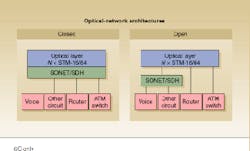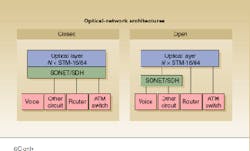Open architecture benefits component manufacturers
Open architecture benefits component manufacturers
Thomas C. Mock
Optical networking components and systems are moving inexorably into communications architectures--it makes sense for network providers to tap into the greater capabilities that optics offers to build stronger, more re sponsive networks. We believe there are compelling reasons why these architectures should be "open" as they evolve to ensure they remain flexible and interoperable.
Several synchronous optical network (SONET)/synchronous digital hierarchy (SDH) equipment vendors have developed optical networking solutions that integrate time-division multiplexing (TDM) and dense wavelength-division multiplexing (DWDM). The vendors accomplish this integration by providing their TDM gear with wavelength-specific outputs that are then passively combined to create a DWDM signal. While it initially might appear that the integrated approach is a simpler way to implement optical networking, there are limitations inherent in such an approach.
The integrated approach is a closed architecture because it requires that the TDM multiplexing equipment and the DWDM multiplexing equipment come from the same vendor. Furthermore, the integrated approach does not allow other types of equipment with optical interfaces (asynchronous transfer mode switches, for example) to have direct access to the optical transport layer--they must instead pass through an intermediate TDM multiplexing layer, which adds more equipment and more cost.
Open and flexible
A more flexible approach, which we refer to as the open architecture approach, uses standard SONET short-reach interfaces between equipment and puts all wavelength-specific operations in the DWDM equipment (see figure). This allows a wider variety of equipment to connect directly to the DWDM equipment and allows the existing base of legacy equipment to be more easily accommodated. Ciena Communications (Linthicum, MD) calls its open-architecture interface DirectConnect.
Because the DWDM equipment interfaces are standard SONET short-reach, lower-cost interfaces can be selected for any new equipment to be connected to the DWDM layer. These standard interfaces into the DWDM layer also include performance monitoring, so that problems can be isolated in sections and network management is facilitated.
A final advantage of open architecture is that the DWDM terminals can be directly connected to other DWDM terminals. This direct connection eliminates the need for SONET regenerators when DWDM links are concatenated. It also allows for easy wavelength interchange at intermediate sites--because the interfaces into the DWDM layer are not wavelength-specific, wavelengths can be cross-connected between DWDM terminals using just an optical patch cord.
Component options increase
From a component standpoint, the implications of this open architecture are twofold. First, frequency-specific, high-stability lasers corresponding to the International Telecommunications Union (ITU) grid channels are required in the transmitters in the DWDM equipment. Second, low-cost, standard, short-reach interfaces operating at 2.5 Gbit/s are required to link the DWDM equipment to the terminal equipment.
When the frequencies of the high-stability laser used in the transmitters are standardized (as they have been by the ITU), the number of vendors providing these lasers is increased. Furthermore, when all DWDM providers are using similar channel plans, the volume of these frequency-specific lasers is increased. These factors act to increase the variety of components available to equipment manufacturers and to decrease the cost of these devices.
Similar advances occur when low-cost, standard short-reach interfaces are used to interconnect equipment within an office. The variety of component options available to an equipment manufacturer is increased and the cost of these components comes down. As these devices become available as complete interface modules, equipment manufacturers whose expertise lies in areas other than optics can then easily and cost effectively incorporate these interfaces into their products. Manufacturers of high-speed data equipment are already taking advantage of these interfaces at lower speeds. As the cost and ease of implementation for these interfaces improve, even more equipment vendors will adopt this approach.
The adoption of an open architecture approach by transport and terminal equipment manufacturers will increase the flexibility available to service providers. They will be able to more easily provide bandwidth for their customers and they can more easily ensure interoperability between various network elements. This approach also will reduce the cost of the components used in their equipment and allow their equipment to be deployed in more places in the network. o
Closed architecture (left) requires equipment with optical interfaces to pass through an intermediate multiplexing layer before connecting to the optical layer; open architecture permits direct links to the optical layer.
THOMAS C. MOCK is product marketing director of access products for Ciena Communications, 1201 Winterson Rd., Linthicum, MD 21090.

